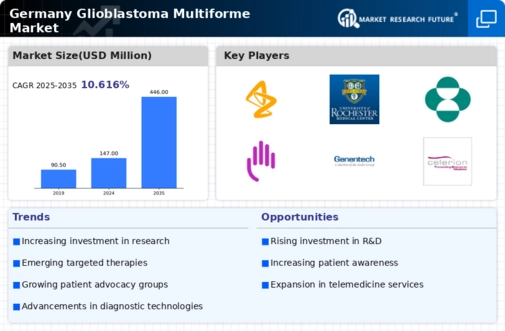Increasing Incidence Rates
The glioblastoma multiforme market in Germany is experiencing growth due to rising incidence rates of this aggressive brain tumor. Recent statistics indicate that glioblastoma accounts for approximately 15% of all brain tumors, with an estimated 5,000 new cases diagnosed annually in Germany. This increasing prevalence necessitates the development of effective treatment options, thereby driving demand within the glioblastoma multiforme market. Furthermore, the aging population in Germany, which is projected to reach 23% of the total population by 2030, is likely to contribute to higher incidence rates, as older individuals are at greater risk for developing glioblastoma. Consequently, the healthcare system is compelled to allocate more resources towards research and treatment, fostering innovation and investment in the glioblastoma multiforme market.
Rising Awareness and Education
Rising awareness and education regarding glioblastoma multiforme are pivotal in shaping the market dynamics in Germany. Increased public and professional knowledge about the disease has led to earlier diagnosis and intervention, which is crucial for improving patient outcomes. Campaigns aimed at educating healthcare professionals and the general public about the symptoms and treatment options for glioblastoma have gained traction. This heightened awareness is reflected in the growing number of patients seeking specialized care, thereby driving demand within the glioblastoma multiforme market. Furthermore, educational initiatives are likely to encourage participation in clinical trials, which can accelerate the development of new therapies. As awareness continues to rise, it is anticipated that the glioblastoma multiforme market will experience sustained growth, ultimately benefiting patients and healthcare providers alike.
Supportive Regulatory Environment
A supportive regulatory environment is fostering growth in the glioblastoma multiforme market in Germany. Regulatory agencies are increasingly prioritizing the approval of innovative therapies, streamlining the process for bringing new treatments to market. Initiatives aimed at expediting the review of drugs targeting rare and aggressive cancers, such as glioblastoma, are becoming more common. For example, the European Medicines Agency has implemented programs to facilitate faster access to promising therapies. This regulatory support not only encourages pharmaceutical companies to invest in glioblastoma research but also enhances patient access to cutting-edge treatments. As a result, the glioblastoma multiforme market is likely to benefit from a continuous influx of novel therapies, ultimately improving patient care and outcomes.
Investment in Research and Development
Investment in research and development (R&D) is a crucial driver for the glioblastoma multiforme market in Germany. The government and private sectors are increasingly funding initiatives aimed at discovering novel therapies and improving existing treatment modalities. In 2023, R&D expenditure in the healthcare sector reached approximately €40 billion, with a significant portion directed towards oncology research. This financial commitment is expected to yield advancements in targeted therapies and immunotherapies, which may enhance treatment outcomes for glioblastoma patients. Additionally, collaborations between academic institutions and pharmaceutical companies are fostering innovation, leading to the development of cutting-edge therapies that could transform the glioblastoma multiforme market landscape. As a result, the focus on R&D is likely to stimulate growth and improve patient care in the coming years.
Technological Advancements in Treatment
Technological advancements in treatment modalities are significantly influencing the glioblastoma multiforme market in Germany. Innovations such as precision medicine, which tailors treatment based on individual genetic profiles, are becoming increasingly prevalent. The integration of advanced imaging techniques and minimally invasive surgical procedures is enhancing the efficacy of glioblastoma treatments. For instance, the use of intraoperative imaging has improved surgical outcomes, allowing for more precise tumor resections. Additionally, the development of novel drug delivery systems, such as nanoparticles, is expected to enhance the therapeutic efficacy of existing treatments. These technological advancements not only improve patient outcomes but also attract investment in the glioblastoma multiforme market, as stakeholders recognize the potential for improved treatment options and increased survival rates.

















Leave a Comment